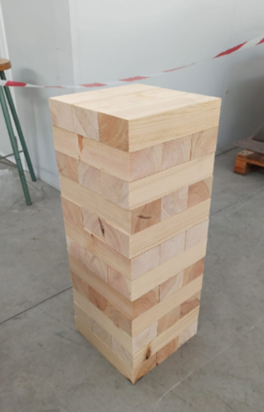Cada grupo dispondrá de un tiempo máximo de 10 minutos para conseguir construir la torre más alta posible.

- OBJETIVO Y DESCRIPCIÓN DE LA PRUEBA
Se propone el clásico juego de la Jenga, pero al estilo de los ingenieros de caminos: ¡con grandes bloques de madera! La prueba consiste en construir una torre de bloques de madera de la mayor altura posible.
- BASE CIENTÍFICA Y TECNOLÓGICA
Con esta prueba se trabajará el concepto de equilibrio de las cargas verticales, en concreto, el peso propio, en elementos de gran altura..
- HERRAMIENTAS Y ÚTILES NECESARIOS
Cada equipo tendrá un total de 36 bloques prismáticos de madera de 6 x 9 x 27 cm (orientativo). Los participantes dispondrán de guantes de protección.
Cada grupo tendrá de un tiempo máximo de 10 minutos para conseguir construir la torre más alta siguiendo la secuencia de ejecución que se indica a continuación:
- En primer lugar, todos los miembros de cada equipo deberán construir una torre compacta de madera, de 12 niveles colocando 3 bloques en cada uno de los niveles. Estos se colocarán perpendiculares con respecto a los del nivel inferior (Ver imagen).
- Una vez construida la torre, los participantes se retirarán a la zona de espera. El juez la examinará y una vez compruebe que está correcta, dará la señal para que empiece la siguiente fase del juego.
- En ese momento, uno de los miembros del equipo se moverá a la zona de juego y comenzará su turno de construcción. El jugador deberá retirar una pieza de cualquier parte de la torre, siempre por debajo del último piso completo, y colocarla en la parte superior. De esta forma, se irán construyendo nuevos pisos y ganando altura.
- Cuando un jugador haya finalizado su turno de construcción, se desplazará a la zona de espera, chocará su mano al siguiente jugador, y empezará un nuevo turno de construcción. Los jugadores irán rotando en fila, de forma que el jugador que llegue de hacer su turno irá a la última posición.
- El juego finaliza cuando los jueces indiquen la señal de los 10 minutos. En ese momento, los jugadores que estén en su turno de juego ya no podrán colocar más piezas, deberán retirarse de la torre y levantar las manos. Si tienen una pieza en la mano sin colocar, deberán retirarse con ella y no podrán colocarla. Se contabilizarán 5 segundos para comprobar que la torre es estable.
- Durante la fase de construcción individual, no se puede empezar a construir un nuevo nivel hasta que no se coloquen las tres piezas que completen el nivel actual.
- Durante la fase constructiva, irán participando todos los participantes de manera sucesiva, pero en su turno, sólo participará un miembro del equipo y no podrá salir el siguiente participante hasta que el anterior haya terminado y le haya dado el relevo mediante un choque de manos.
- Sólo se podrá utilizar una mano. Se recomienda que la mano que no se use se guarde en el bolsillo o se coloque en la espalda.
- Durante su turno, el participante puede tocar todas las piezas que quiera, pero tendrá que hacerlo de una en una, sin tocar varias piezas simultáneamente.
- Si toca varias piezas a la vez con su mano o utiliza las dos manos, se penalizará con 15 segundos sin poder tocar la torre ni las piezas. El participante deberá esperar la señal del juez para poder reanudar el juego.
- Se permite rectificar la posición de las piezas siguiendo lo descrito anteriormente.
- Si se cae una pieza al suelo, esa pieza no se podrá utilizar y el participante al que se le haya caído, terminará su turno.
- Si en algún momento durante el juego la torre se cae, total o parcialmente, el proceso de juego comienza desde el punto 1. Es decir, todos los miembros del equipo irán a la zona de juego y deberán construir la torre inicial. El juez hará la verificación, y comenzarán otra vez los turnos individuales de construcción.
Los jueces otorgarán una puntuación en función de la altura de la torre, tantos puntos como número de equipos participantes. Los equipos se ordenarán de mayor a menor altura de torre, de manera que el equipo que construya la torre más alta será el ganador y recibirá la máxima puntuación, mientras que el equipo que construya la torre más baja obtendrá la puntuación mínima (1 punto). En caso de empate, se seguirán los siguientes criterios de desempate, que se presentan ordenados en función de su prioridad:
- Criterio 1: Menos caídas de torre. Quedará por delante el equipo al que se le haya caído menos veces la torre.
- Criterio 2: Piso más completo. Quedará por delante el equipo que tenga más bloques en el último piso. Pueden ser 1, 2 o 3 bloques.
- Criterio 3: Menor tiempo en construir la torre inicial. Quedará por delante el equipo que haya tardado menos tiempo en construir la torre inicial de 12 pisos completos.
Si, al finalizar el tiempo de juego, la torre está derrumbada y el equipo no ha comenzado a construir la torre inicial, la altura de torre será 0.
Si, al finalizar el tiempo de juego, el equipo está construyendo la torre inicial, la altura de torre será la que tenga la torre inicial en ese momento. Para esta altura, sólo se tendrán en cuenta los pisos que tengan los bloques correctamente colocados, con la verificación de los jueces.